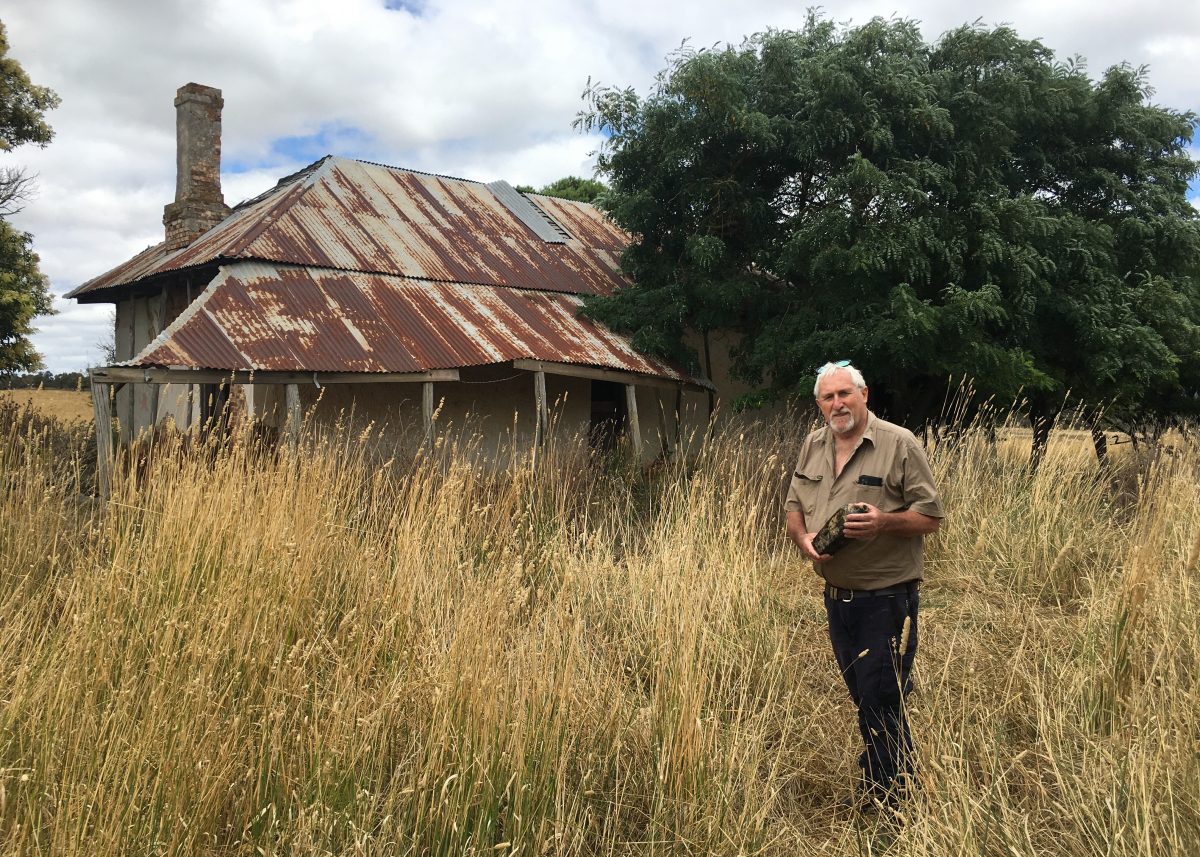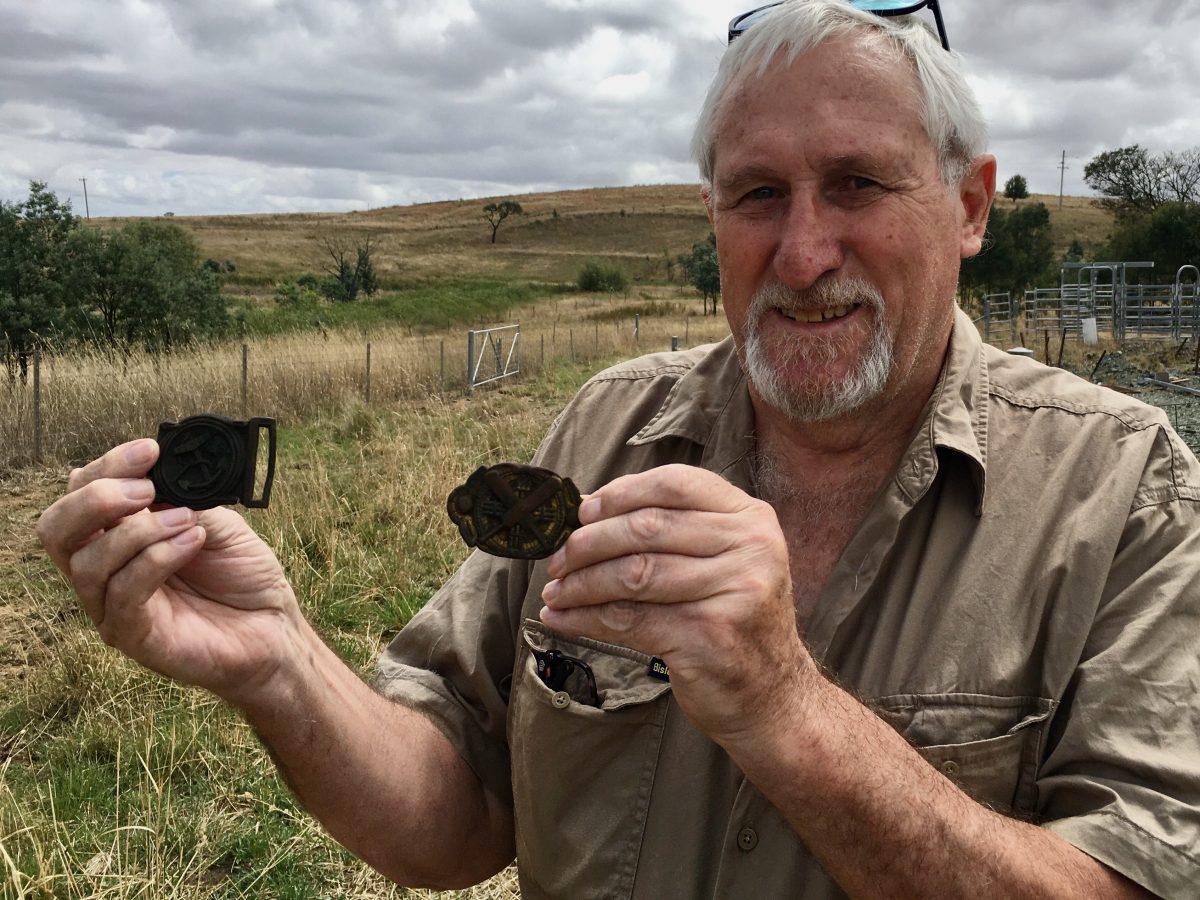
Ray Mooney with a rum bottle, most likely one from the 1860s mining era. The Old Currawang homestead is in the background. Photo: John Thistleton.
A large dam on Ray Mooney’s 600-acre (242-hectare) property south of Goulburn, “Old Currawang”, is so clear he is considering restocking it with golden and silver perch. This is remarkable considering water has drained through heavily mined and processed copper ore since the 1860s, and lead, zinc, copper, gold and silver mining in the late 1980s.
Fossickers have turned up treasures beneath the surface. Above the ground, clear water and birdlife on the 50-megalitre dam reveal the value of what has happened over the decades on land that once had a village sitting on top of it.
A blacksmith’s shop, two pubs, four stores, a school and miners’ homes were built around the original 1840s Currawang homestead that Ray believes convicts constructed for the Coopers, the original European settlers who had owned nearly all of the country between Collector and Tarago. Under rusting corrugated iron, the two-room, brick-and-timber home had a separate kitchen. Two deep wells and remnants of a piggery and dairy surround the home.
Of all the coins, bottles and buckles fossickers have unearthed in recent times, cricket buckles are reminders of the social activities that once played out on his land, where cattle, kangaroos and deer graze today.
“I would assume the miners, when they were not mining, wanted to do something in their spare time and cricket was the big thing in those days,” Ray said.
“They would have matches just between themselves, that was the big social event from what I can see,” he said. “The buckles were all pressed metal and would have had a backing plate for them.”
Ray said the buckles were not affixed to belts, but sashes that held up the men’s trousers.
“I suppose it was just part of the ornaments they had to sort of look good,” he said.

Currawang East diamond drillers working underground. This photo was taken by Dennis Fortowski, at the time a geologist at Woodlawn Mine and one of the few people who went underground at the Currawang East mine.
Canberra fossicker Tom Collins has found an 1875 Queen Victoria penny, made in the United Kingdom, at the old Currawang school site, and a 1905 King Edward VII halfpenny. Using a metal detector across the rock-hard ground, Tom has to distinguish between multiple signals to determine what he is likely to dig up.
“It was hard work, I can tell you,” he said.
Ray’s parents Fons and Margaret moved from Cooma to Goulburn in the mid-1960s after his late great-uncle Jim Galvin left the place to the Mooneys. Part of an influx of Irish Catholics, the Galvins had bought the Currawang land in the 1930s and had lived in the district since the 1850s. Other notable families related to Ray include the Reardons and Poidevins. He has researched more than 100 different families with links to Currawang and is looking for a writer to turn his extensive research into a book.
Ray attended Inverolochy agricultural boarding school for four years and St Patrick’s boarding college and later joined the NSW Lands Department, a role that helps guide his research into Currawang.
Lake George can be seen in the distance from Old Currawang and he returned there while working for the Lands Department to reappraise all the land on the lake over the next 30 years.
“I remember taking film crews out there looking at the site,” he said. “They were looking at filming part of the series for Mad Max: Fury Road at one stage.”
The green lake-bed landscape was deemed unsuitable for the film, which needed a post-apocalyptic desert wasteland.
Mining company Denehurst resumed operations at Currawang in the late 1980s, going underground and mining copper, lead, zinc, silver and gold. When it finished mining, it pumped water from the underground mine into a small dam, established a wetland area and the big 50 ML dam to help rehabilitate the site.

Ray Mooney with two cricket buckles that date back to the 1860s. In the background is a slope that covers previous mining activity and wetlands that run between two dams. Photo: John Thistleton.
The 1860s-1880s mining included two smelters that needed huge amounts of firewood. In Historic Mining Sites in the Monaro Southern Tablelands Districts of New South Wales, author Barry McGowan said among the 110 miners were 15 wood-carting teams that cut many thousands of tons of firewood for the smelters.
Time and technology add to the fascination of what happened in an earlier era of ingenuity and toil.






